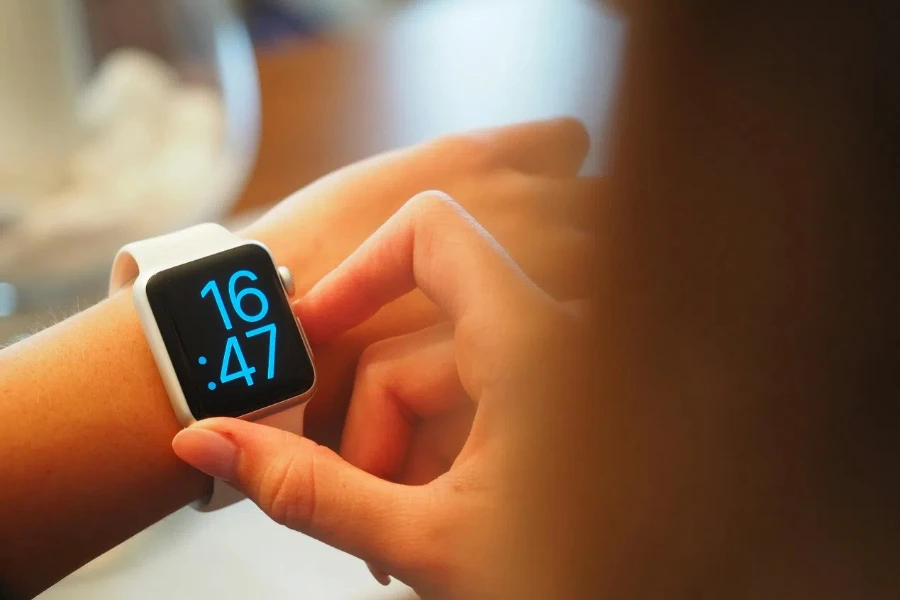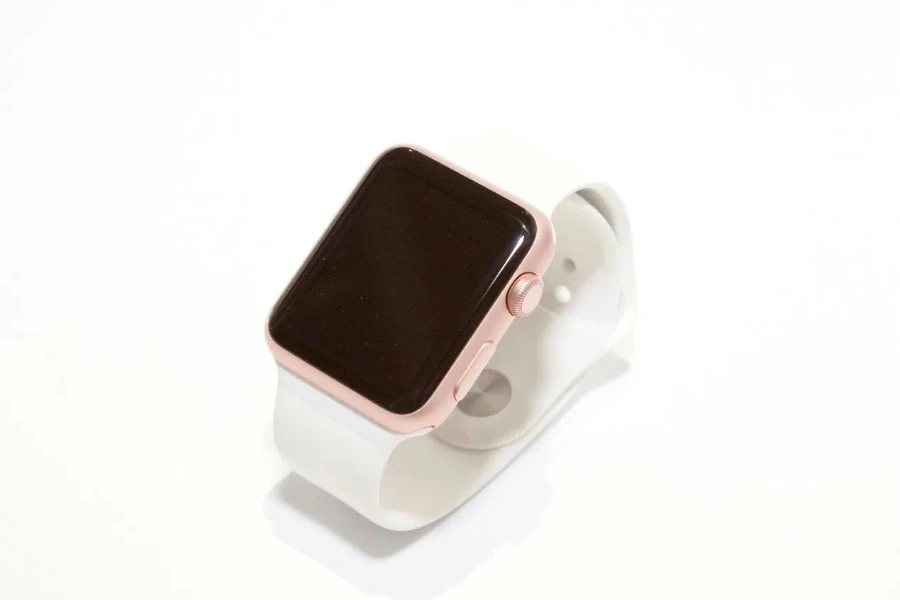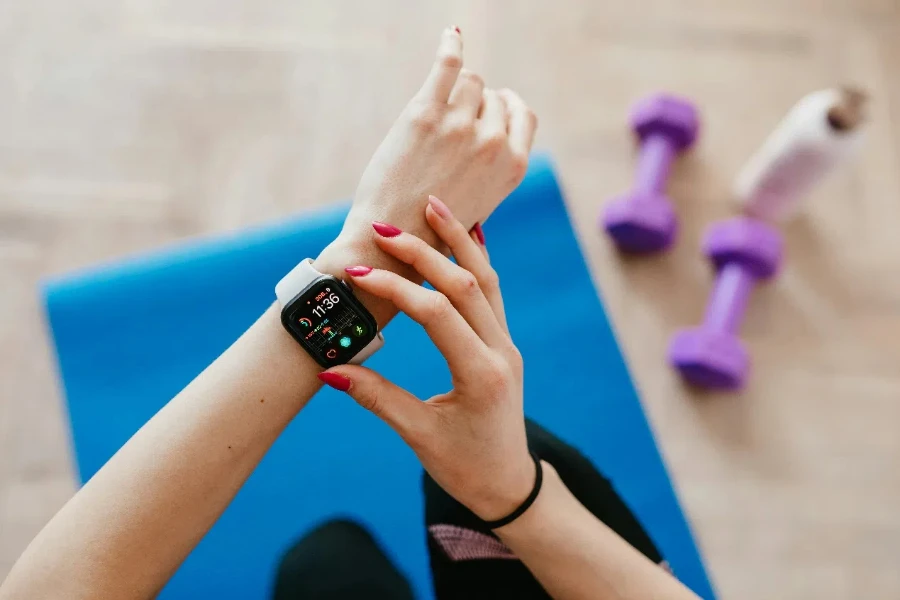The global smartwatch market is experiencing rapid growth, driven by rising health awareness and innovative technologies. This article provides an in-depth look at the increasing demand for smartwatches designed for women, highlighting market dynamics, key features, and future trends to assist professional buyers in making informed decisions.
Table of Contents:
– Smart Watches for Women: Market Overview
– In-Depth Analysis of Smart Watches for Women
– Key Factors When Selecting Smart Watches for Women
– The Evolution of Smart Watches for Women
– Smart Watches for Women: Future Trends
– Wrapping Up
Smart Watches for Women: Market Overview

Rising Popularity and Market Growth
The global smartwatch market is experiencing substantial growth. The market size is expected to increase from $77.91 billion in 2023 to $91.8 billion in 2024, at a compound annual growth rate (CAGR) of 17.8%. By 2029, the shipment volume is projected to reach 583.81 million units, growing at a CAGR of 27.78%. This growth is driven by urbanization and the increasing demand for advanced, aesthetically appealing products that cater to consumers’ needs for time management and multifunctional devices.
The millennial population’s increased spending on tracking and luxury standards significantly influences the demand for smartwatches. The smartwatch market has an annual growth rate (CAGR) of 7.15% from 2024 to 2029. By 2029, the projected market volume will be US$40.57 billion. User penetration is predicted to rise from 5.87% in 2024 to 9.19% by 2029, with an average revenue per user (ARPU) estimated at US$63.17.
Key Market Drivers and Dynamics
Several key factors fuel the smartwatch market’s expansion. These include the growing consumer focus on health and fitness and the convenience of receiving notifications and performing tasks directly from the wrist. Technological advancements, such as enhanced connectivity, increased battery life, and sophisticated health-monitoring sensors, also favor market growth. The United States is expected to generate the most revenue in the smartwatch market in 2024, amounting to US$9,069.00 million.
The integration of smartwatches into corporate wellness programs and the increasing adoption of the Internet of Things (IoT) and connected devices are significant drivers. For instance, the introduction of the Fused Environment Method technique, which combines real and virtual worlds to enhance user experience, benefits market growth. Additionally, developing new energy-efficient technologies that enhance data encryption and create more personalized user experiences is fueling market expansion.
Regional Insights and Growth Patterns
Asia-Pacific is expected to witness significant growth in the smartwatch market due to the growing consumer electronics industry and the rapid rise of smartwatch vendors across the region’s emerging economies. The increasing tech-savvy population, a rising pool of chronic diseases like obesity and diabetes, and the growing popularity of health and fitness to maintain a healthy lifestyle drive the market’s growth. For instance, a survey conducted in July 2023 by Transform Rural India indicated that the average monthly medical expenses in India for chronically ill patients were about INR 6 thousand.
In China, the wearables market has taken a different shape, fueled partly by purchases from growing affluent consumers. According to a government think tank report, approximately 80% of the world’s smart wearable devices are manufactured in the southeastern Chinese port city and manufacturing hub. The growing urbanization rates in regions like China and India have increased the demand for modern, visually appealing products that can better satisfy consumers’ needs, such as several functionalities in one device and time management.
In-Depth Analysis of Smart Watches for Women

Key Performance Benchmarks and Market Share Dynamics
The global smartwatch market is characterized by increasing health awareness among consumers, driving the demand for smartwatches with health monitoring features. For instance, smartwatches with heart rate tracking, blood oxygen levels, ECG capabilities, and blood pressure monitoring provide users with valuable health insights. The medical segment is expected to hold a considerable market share due to the continuous monitoring of health parameters and timely alerts, aiding better disease management and adherence to treatment plans.
The market is also influenced by the rising prevalence of women-centric diseases such as anemia, osteoporosis, breast cancer, and menopause. Smartwatches offer valuable health monitoring, emergency assistance, and activity tracking features, particularly beneficial for the aging population. For instance, in 2023, around 300,590 people in the U.S. were estimated to be diagnosed with breast cancer, highlighting the need for continuous health monitoring.
Economic Influences and Consumer Behavior Shifts
Economic influences on the smartwatch market include rising costs of materials and logistics due to global supply chain disruptions. For example, Ukraine and Russia are significant suppliers of raw materials like palladium and neon gas, essential for semiconductor production. These disruptions can lead to shortages and delays in producing smartwatches and other electronics, resulting in higher prices that may dampen demand.
Consumer behavior shifts towards proactive health management and preventive care are also driving the demand for smartwatches with advanced health monitoring capabilities. The convenience of accessing healthcare services directly from the wrist is a key driver for many individuals when choosing a smartwatch. Additionally, the increasing adoption of smartwatches for contactless payments and seamless integration with telemedicine platforms is influencing consumer preferences.
Innovations and Product Lifecycle Stages
Recent innovations in the smartwatch market include advanced sensors, extended battery life, and sophisticated health-monitoring features. For instance, Apple launched the latest WatchOS 10 with enhanced connectivity and live cycling activity display. The integration of artificial intelligence (AI) for personalized health insights and the popularity of standalone smartwatches that function without a smartphone are key market trends.
The product lifecycle stages of smartwatches involve continuous improvements in design, functionality, and user experience. Companies are focusing on developing stylish, fashion-forward designs that cater to consumer aesthetics alongside functionality. For example, the Amazfit Balance launched by Zepp Health Corporation in November 2023 aims to help users achieve a harmonious balance between their personal, professional, and well-being pursuits.
The global smartwatch market is poised for significant growth, driven by technological advancements, increasing health awareness, and the integration of smartwatches into everyday life. With the rising demand for health monitoring features and the convenience of wearable technology, smartwatches are set to become an essential part of daily life for many consumers worldwide. As companies continue to innovate and expand their product offerings, the smartwatch market is expected to see substantial growth in the coming years.
Key Factors When Selecting Smart Watches for Women

When choosing a smartwatch for women, several key factors ensure the device meets specific needs and preferences. These include design, functionality, build quality, compatibility, and price. Below are detailed considerations for each factor.
Design and Aesthetics
The design and aesthetics of a smartwatch are crucial, as the device often doubles as a fashion accessory.
Stylish Appearance
Modern smartwatches for women come in various styles, from sleek, minimalist designs to more elaborate, jewel-encrusted models. Brands like Apple, Samsung, and Garmin offer a range of options. For instance, the Apple Watch Series 9 comes in multiple strap colors such as Midnight, Starlight, and Red, allowing for personalization.
Customizable Watch Faces
Customizable watch faces enable users to match their smartwatch to their outfit or mood. Many smartwatches, including the Samsung Galaxy Watch 6, offer this feature, providing a variety of designs and themes to choose from.
Material and Finish
The material and finish of a smartwatch can significantly impact its look and feel. Options include stainless steel, aluminum, and ceramic. The Xiaomi Watch 2 Pro, for example, features a sleek stainless steel design that is both stylish and durable.
Functionality and Performance
Functionality and performance are critical when choosing a smartwatch, as they determine the device’s overall utility.
Health and Fitness Tracking
Advanced health and fitness tracking features are a must for many users. Smartwatches like the Apple Watch Series 9 and Garmin Forerunner 255 offer comprehensive health monitoring, including heart rate, ECG, blood oxygen levels, and sleep tracking. The Fitbit Charge 6 expands this with stress management tools and personalized workout plans.
Connectivity Options
Connectivity options such as Bluetooth, Wi-Fi, and cellular capabilities are essential for staying connected on the go. The Xiaomi Watch 2 Pro offers 4G LTE connectivity, allowing users to make calls and send texts without needing their smartphone.
Battery Life
Battery life is a significant consideration, especially for users who engage in extended activities. The Samsung Galaxy Watch 6 boasts a battery life of up to 21 days, making it ideal for long-term use without frequent charging.
Build Quality and Durability
The build quality and durability of a smartwatch ensure it can withstand daily wear and various environmental conditions.
Water and Dust Resistance
Water and dust resistance are crucial for users who engage in outdoor activities or sports. The Apple Watch Series 9 is swim-proof and dust-resistant, making it suitable for various environments.
Scratch and Impact Resistance
Scratch and impact resistance enhance the longevity of the smartwatch. The Apple Watch Series 8 GPS + Cellular, for example, features a crack-resistant display, ensuring durability even in harsh conditions.
Robust Construction
A robust construction is essential for users who lead active lifestyles. The Garmin Forerunner series is known for its rugged design, capable of withstanding demanding training sessions and outdoor adventures.
Compatibility and Integration
Compatibility with other devices and seamless integration with various ecosystems are vital for a smooth user experience.
Operating System Compatibility
Smartwatches should be compatible with the user’s smartphone operating system. The Apple Watch Series 9 is designed for seamless integration with iOS devices, while the Samsung Galaxy Watch 6 is optimized for Android users.
App Ecosystem
A rich app ecosystem enhances the functionality of the smartwatch. Apple and Samsung offer extensive access to third-party apps, enabling users to customize their experience based on their needs and preferences.
Price and Value
Price and value are important considerations, as they determine the affordability and overall worth of the smartwatch.
Price Range
Smartwatches are available in various price ranges, from budget-friendly options to premium models. The Apple Watch Series 9 is priced around INR 39,243, while the Xiaomi Watch 2 Pro is available for INR 39,000, providing high-end features at competitive prices.
Value for Money
The value for money is determined by the features and performance offered at a given price point. Smartwatches like the Garmin Forerunner 255 and Fitbit Charge 6 provide excellent value with their advanced health tracking and robust build quality.
The Evolution of Smart Watches for Women

The evolution of smartwatches for women has seen significant advancements in design, functionality, and technology.
Technological Advancements
Advanced Health Monitoring
Recent models, such as the Apple Watch Series 9, have introduced advanced health monitoring features, including continuous glucose monitoring and enhanced fitness tracking with VO2 max estimation and smarter heart rate monitoring.
Enhanced Connectivity
Smartwatches now offer enhanced connectivity options, including 4G LTE and seamless integration with other devices. The Xiaomi Watch 2 Pro, for instance, allows users to stay connected without needing their smartphone.
Design Improvements
Sleeker Designs
The design of smartwatches has become sleeker and more stylish, catering to the preferences of women who want a device that doubles as a fashion accessory. The Samsung Galaxy Watch 6, with its elegant design and multiple strap options, exemplifies this trend.
Customization Options
Increased customization options, such as interchangeable straps and customizable watch faces, allow users to personalize their smartwatches to match their style. This feature is prevalent in models like the Apple Watch Series 9 and Samsung Galaxy Watch 6.
Market Trends
Growing Demand for Health Features
There is a growing demand for smartwatches with advanced health features, driven by increased health consciousness among consumers. Models like the Fitbit Charge 6, with its focus on stress management and sleep tracking, are becoming increasingly popular.
Integration with Smart Ecosystems
The integration of smartwatches with broader smart ecosystems is a notable trend. Devices like the Apple Watch Series 9 and Samsung Galaxy Watch 6 offer seamless integration with their respective ecosystems, enhancing the overall user experience.
Smart Watches for Women: Future Trends

Looking ahead, several trends are likely to shape the future of smartwatches for women.
Emerging Technologies
Advanced Health Sensors
The incorporation of advanced health sensors, such as those for continuous glucose monitoring and more accurate heart rate measurements, will continue to evolve. These features will provide users with more comprehensive health insights.
AI and Machine Learning
The use of AI and machine learning in smartwatches will enhance their ability to provide personalized recommendations and insights. This technology will enable smartwatches to learn from user behavior and offer tailored advice.
Design Innovations
Sustainable Materials
The use of sustainable materials in smartwatch manufacturing is expected to increase, driven by growing environmental awareness. Brands will likely adopt eco-friendly materials for straps and casing.
Enhanced Customization
Future smartwatches will offer even more customization options, allowing users to personalize their devices to an unprecedented degree. This trend will cater to the diverse preferences of women users.
Market Expansion
Broader Accessibility
As technology advances and production costs decrease, smartwatches will become more accessible to a broader range of consumers. This will lead to increased market penetration and adoption.
Diverse Offerings
Brands will continue to diversify their offerings, introducing models tailored to specific needs and preferences. This will include smartwatches designed for different activities, such as fitness, fashion, and professional use.
Wrapping Up
In summary, smartwatches for women have evolved significantly, offering advanced health features, stylish designs, and enhanced connectivity. With emerging technologies and future trends, the market for smartwatches for women is set to expand, providing even more options to cater to diverse preferences and needs.




